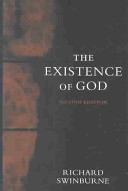Help Wanted – Part 3

A key premise in Swinburne’s (deductive) argument in defense of his inductive version of the Cosmological argument (TCA) goes like this:
(TCA9) The probability that there will be a complex physical universe given that God does not exist is low. (EOG, p.151)
Based on Swinburne’s explanation of his reasoning in support of this premise (in email dated 10/24/11), I understand his argument for (TCA9) to be (roughly) as follows:
1. P(e&~h&~c&k;) is approximately equal to P(eI~h&~c&k;)
2. P(eI~h&~c&k;) is approximately equal to P(eI~h&k;)
Therefore:
3. P(e&~h&~c&k;) is approximately equal to P(eI~h&k;)
4. P(e&~h&~c&k;) is a very low probability.
Therefore:
5. P(eI~h&k;) is a low probability (at most).
I take it that (5) is equivalent to (TCA9). So, a good argument for (5) would be a good argument for (TCA9).
Swinburne is very knowledgeable about conditional probability and Bayes’s Theorem, so his reasoning is a bit condensed. It took me a few days to work out the detailed steps of logic and math required to get to premise (1) from his assumptions. Having figured this out, I can walk through Swinburne’s reasoning, showing the step-by-step logical and mathematical details that validate this reasoning. Fortunately, the level of math and logic involved is pretty basic and easy, at least once it has been layed out.
[Swinburne:] Let c be ‘there is a personal creator other than God’.
This first sentence from Swinburne’s email needs no explanation. I will just point out that c in conjunction with h ( meaning ‘God exists’) are supposed to exhaust the logical possibilities concerning a personal explanation of the existence of a complex physical universe.
[Swinburne:] Then (given the sentence on p.149, ‘e could not, as we have seen..’), with k as a mere tautology, P(e&~h&~c&k;) will be the probability that a complex physical universe exists without an explanation.
I explained this in the previous post (Part 2), but will repeat the explanation here. Swinburne has previously concluded that there can be no scientific explanation for the existence of a complex physical universe, so assuming that the only other kind of explanation that can be given is a personal explanation (in terms of a creator, or group of creators, who has some purpose or purposes for making a complex physical universe) the denial of the existence of God (~h) combined with the denial of any other personal creator (~c) eliminates the possibility of a personal explanation, and thus there would be no explanation for the existence of a complex physical universe.
[Swinburne:] By the calculus this equals P(eI~h&~c&k;) P(~h&~c&k;).
The pronoun ‘this’ here refers to the probability statement that, in Swinburne’s view, relates to the possibility that a complex physical universe exists without an explanation: P(e&~h&~c&k;). So the first bit of reasoning (‘by the calculus’) gets us to this equation:
P(e&~h&~c&k;) = P(eI~h&~c&k;) P(~h&~c&k;)
1. P(AIB) = P(A&B;)/P(B)……………………………..Conditional Probability Formula*
2. P(AIB) x P(B) = [P(A&B;)/P(B)] x P(B)………….1, multiply both sides by P(B)
3. c/d x d = c……………………………………………………………..See proof below
4. [P(A&B;)/P(B)] x P(B) = P(A&B;)……………………….3, instance of the formula
5. P(AIB) x P(B) = P(A&B;)…………………………………….2,4 transitivity of equality
6. P(A&B;) = P(AIB) x P(B)………………………………………5, symmetry of equality
7. P(e&~h&~c&k;) = P(eI~h&~c&k;) x P(~h&~c&k;)…..6, instance of the formula
* requires that P(B) not be equal to zero (to avoid division by zero, which is undefined).
Prove: c/d x d = c
1. c/d = c x 1/d…………………………….multiplication by reciprocal
2. c/d x d = (c x 1/d) x d…………………1, multiply both sides by d
3. (c x 1/d) x d = c x (1/d x d)……..associative prop. of multiplication
4. c/d x d = c x (1/d x d)………………2,3 transitivity of equality
5. 1/d x d = d x 1/d………………..commutative prop. of multiplication
6. d x 1/d = 1…………………………………..axiom of multiplicative inverse
7. 1/d x d = 1……………………………….5,6 transitivity of equality
8. c/d x d = c x 1……………………………7,4 substitution of equals
9. c x 1 = c………………………………….identity element for multiplication
10. c/d x d = c…………………………..8,9 transitivity of equality
symmetry of equality: If a = b, then b = a.
transitivity of equality: If a = b and b = c, then a = c
multiplication property of equality: If a = b, then a x c = b x c
associative property of multiplication: (a x b) x c = a x (b x c)
commutative property of multiplication: a x b = b x a
identity element for multiplication: a x 1 = a
axiom of
multiplicative inverse: a x 1/a = 1
To be continued…
